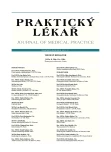Basics of social cognitive and affective neuroscience. XVIII. Interoception and emotional background
Authors:
Koukolík; F
Authors‘ workplace:
Primář: MUDr. František Koukolík, DrSc.
; Národní referenční laboratoř prionových chorob
; Thomayerova nemocnice, Praha
; Oddělení patologie a molekulární medicíny
Published in:
Prakt. Lék. 2012; 92(5): 251-256
Category:
Editorial
Overview
Damasio proposes that emotions are part of multi-tiered, hierarchical and evolutionary set neural mechanisms aimed at maintaining organism homeostasis. Part of this mechanism and so-called emotional background is Craig’s interoception, the sense of the physiological condition of the body. Primates have a distinct cortical image of homeostatic afferent activity in the posterior insula. In humans there exists metarepresentation of the primary interoceptive activity in the anterior insula and other parts of the brain. Interoceptive awareness drives increased rational decision-making and enhances neural activity during empathy.
Key words:
emotional background, interoception, interoceptive system, insula
Sources
1. Bartels A, Zeki S. The neural basis of romantic love. Neuroreport 2000; 11, p. 3829–3834.
2. Blood A. J., Zattore R. Intensely pleasurable response to music correlate with activity in brain regions implicated in reward and emotion. Proc Natl Acad Sci USA 2001, 98, p. 11818–11823.
3. Cauda F, D’Agata F, Sacco K., et al. Functional connectivity of insula in the resting brain. NeuroImage 2011;35, p. 8–23.
4. Craig AD. How do you feel? Interoception: the sense of the physiological condition of the body. Nat Rev Neurosci 2002; 3, p. 655–666.
5. Craig AD. Interoception: the sense of physiological condition of the body. Curr Opin Neurobiol 2003; 13, p. 500–505.
6. Craig AD. How do you feel-now? The anterior insula and human awareness. Nat Rev Neurosci 2009; 10, p. 59–70.
7. Critchley HD, Mathias CJ, Dolan RJ. Neuroanatomical basis for first and second-order representations of bodily states. Nat Neurosci 2001; 4, p. 207–211.
8. Critchley H. The human cortex responds to an interoceptive challenge. Proc Natl Acad Sci 2004; 101, p. 6333–6334.
9. Critchley HD, Wiens S, Rothestein, et al. Neural systems supporting interoceptive awareness. Nat Neurosci 2004; 7, p. 189–195.
10.Damasio A. The feeling of what happens: body and emotion in the making of consciousness. New York: Harcourt Brace, 1999.
11. Damasio A. Descartesův omyl. Emoce, rozum a lidský mozek. Praha: Kolumbus 2000.
12. Damasio A, Grabowski TJ, Bechara A, et al. Subcortical and cortical brain activity during the feeling of self-generated emotions. Nat Neurosci, 2000; 3, p. 1049–1056.
13. Damasio A. Fundamental feelings. Nature 2001; 413, p. 781.
14. Damasio A. Hledání Spinozy. Radost, strast a citový mozek. Praha: Dybbuk, 2003/2004.
15. Ernst J, Northoff G, Böker H, et al. Interoceptive awareness enhances neural activity during empathy. Hum Brain Mapp 2012; doi:10.1002/ hbm.22014.
16. Frith CD, Frith U. Interacting minds – a biological basis. Science 1999; 286, p. 1692–1695.
17. Kirk U, Downar J, Montague PR. Interoception drives increased rational decision-making in meditators playing the ultimatum game. Front Neurosci 2011; 5, p. 1–11.
18. Koukolík F. Základy kognitivní, afektivní a sociální neurovědy II. Empatie. Prakt. lék. 2011; 91, s. 63–67.
19. Koukolík F. Lidský mozek. Funkční systémy. Norma a poruchy. Třetí doplněné a rozšířené vydání. Praha: Galén, 2012.
20. Luders E, Toga AW, Lepore N, et al. The underlying anatomical correlates of long term mediation: larger hippocampal and frontal volumes of gray matter. NeuroImage 2009;45, p. 672–678.
21. Lutz A, Slagter HA, Dunne JD, et al. Attention regulation and monitoring in meditation. Trends Cogn Sci 2008; 12, p. 163–169.
22. Lutz A, Greischar LL, Perlman D, et al. BOLD signal in insula is differentially related to cardiac function during compassion meditation in experts vs. novices. NeuroImage 2009; 47, p. 1038-1046.
23. Motlová L., Koukolík F. Citový mozek. Neurobiologie, klinický obraz, terapie. Praha: Galén, 2006.
24. Mutschler T, Wieckhorst B, Kowalevski S, et al. Functional organization of anterior insular cortex. Neurosci Lett 2009, 26, p. 66–70.
25. Paus T. Primate anterior cingulate cortex: where motor control, drive and cognition interface. Nat Rev Neurosci 2001; 2, p. 417–424.
26. Pollatos O, Kirsch W, Chandry R. On the relationship between interoceptive awareness, emotional experience, and brain processes. Brain Res Cogn Brain Res 2005; 25, p. 948–962.
27. Tang YY, Ma Y, Fan Y, et al. Central and autonomic nervous system interactions is altered by short term meditation. Proc Natl Acad Sci 2009; 106, p. 8865–8870.
28. Websterův slovník: Random House Webster´s Unabridged Dictionary. 2nd edition. New York: Random House, 1998.
29. Weiss T, Straube T, Boettcher J et al. Brain activation upon selective stimulation of C-and A-δ fibers. NeuroImage 2008; 41, p. 1372–1381.
Labels
General practitioner for children and adolescents General practitioner for adultsArticle was published in
General Practitioner

2012 Issue 5
Most read in this issue
- REM behavior disorder – a neglected diagnosis
- Eosinophilic pneumonia and systemic vasculitis
- Atypical course of pneumonia with extrapulmonary complications due to Mycoplasma pneumoniae infection
- Basics of social cognitive and affective neuroscience. XVIII. Interoception and emotional background
